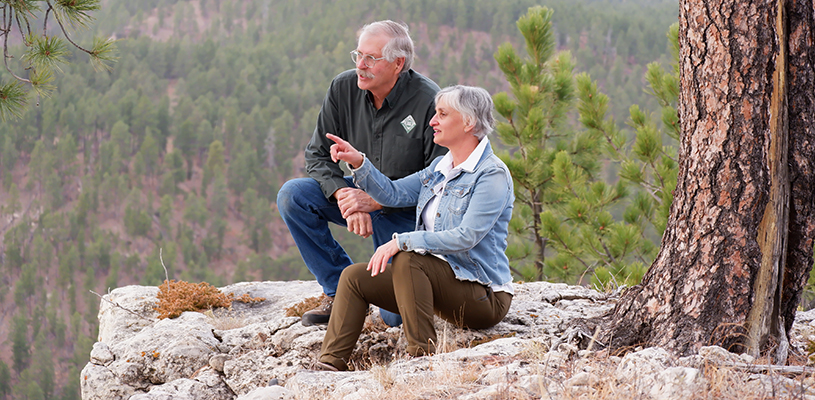
Bob Burns CC’71 and Mary LaHood.
In the early morning hours of August 15, 1994, Bob Burns and his wife, Mary LaHood, were jolted from sleep when their home in Piedmont, South Dakota, was illuminated by the glow of an encroaching fire from nearby Stagebarn Canyon. Racing to a command center set up at a local school, Burns CC’71 drew on his Environmental Science degree from Rutgers and his 30 years of work with the U.S. Forest Service to guide a team in creating two miles of fire line over the next 14 hours to contain the blaze.
No homes were destroyed, but 80 acres of the LaHood-Burns Family Forest was devastated in the inferno, prompting Burns to step up his efforts at preserving forest health and managing the land. The couple’s work over the ensuing years was recognized in December 2021 when the American Forest Foundation named Burns and his wife as the American Tree Farm System (ATFS) 2021 National Outstanding Tree Farmers of the Year.
“I can attest to their commitment to building community among forest landowners, in addition to caring for their land in a way that would make past and future generations proud,” said Angela Wells, director of the ATFS, in announcing the award. The ATFS is the country’s largest sustainable woodland program, with a network of more than 70,000 family forest owners managing nearly 19 million acres of forestland. Family forest owners like Burns and his wife care for the largest number of acres of forest in the United States, surpassing even government and corporate holdings.
Located west of Rapid City, South Dakota, and surrounded by Black Hills National Forest, the LaHood-Burns Family Forest today covers 320 acres—the remains of 1,000 acres purchased by Burns’s great-grandfather in 1887.
A growing interest in the environment
Burns was introduced to Rutgers by his sister, who was dating the university’s crew team coach at the time. Burns was excited to join the crew team, where he helped give Harvard its first defeat in eight years at the 1971 Eastern Sprints rowing championship. More important, he liked Rutgers’ strong reputation in the sciences—as well as his financial aid package, which included room and board at Helyar House in exchange for helping graduate students with their entomology research.
“Peter Wolf taught a beginning geology course that I took my sophomore year,” Burns says. “His enthusiasm and excitement about geology really led to my interest in the physical world and taking other geology courses both at Rutgers and the South Dakota School of Mines and Technology. The cover of the geology textbook was a photo of the Badlands, which were just a few miles from our home.”
When his father died in 1969, Burns left Rutgers temporarily to manage the family property, returning to complete his degree in 1971. After graduation, Burns got a contract from the U.S. Forest Service to install water systems in a 30-acre lakeside camping area in the Black Hills. He continued working for the Forest Service and the state over the next 30 years, repairing erosion on stream banks, building recreational trails, and restoring damaged forestland—while still doing projects like tree thinning on his family farm when he could.
“I believe it was my experience at Rutgers and especially [on the rowing] crew that gave me the confidence and curiosity to try new things and not give up when things don’t go as well as I hoped they would,” Burns says.
Returning to his roots
The Stagebarn Fire was a turning point for Burns, leading him to come up with a stewardship plan with help from the South Dakota Department of Agriculture’s Forestry Division.
“A professional forester came out, mapped our property, reviewed it with us, and came up with a plan for how we would like to manage the property and the goals we were looking for, such as having a commercial timber sale to salvage the burnt wood,” Burns says. “Getting that stewardship plan led us into the American Tree Farm System.”
Executing that stewardship plan involves a wide range of activities such as tree spacing, cutting down water-guzzling pine trees to create areas for hardwoods to flourish, managing the regrowth of pine trees, promoting water quality, minimizing destruction caused by mountain pine beetles, clearing out invasive weeds, and creating and safeguarding wildlife habitats. It also includes promoting recreational opportunities that respect the land. As a result, Burns installed fencing that permits hikers through on foot but prevents off-road motorized vehicles from ruining the fragile ecosystem in nearby Botany Canyon.
“We enjoy letting people use the property,” Burns says. “The new middle school will take students up there on tours and hikes. Those lessons at Rutgers follow me around, and I try to teach them to people out here. I quote things that I heard in those forestry courses about watersheds and turf management when I take people on tours today.”
Learn more about the efforts of Bob Burns and Mary LaHood to preserve their woodlands in this video on the 2021 National Outstanding Tree Farmers of the Year.
Editor’s Note: This article first appeared on the Rutgers University Alumni Association website.

